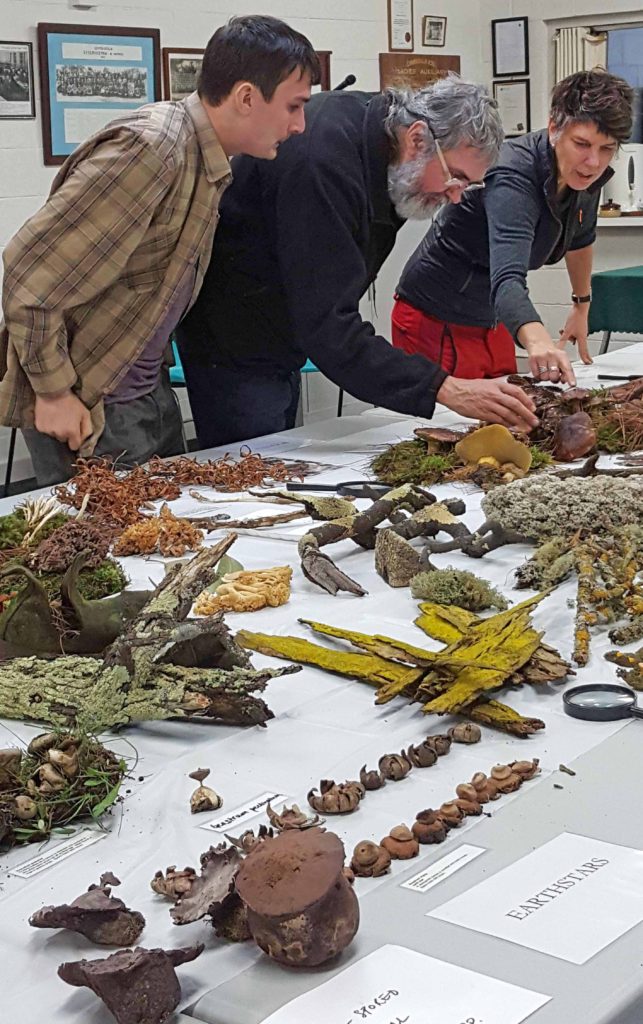While many people associate fungi with damp habitats of wetter forests, Australia’s vast desert areas have their own highly specialised mycota. As with desert fauna and flora, desert fungi are superbly adapted to cope with hostile conditions such as extreme temperatures, limited availability of water and nutrients, high ultraviolet radiation and strong and abrasive winds.

Although poorly understood, with most probably yet to be scientifically described or their distributions documented, desert fungi such as truffle-like fungi are known in Australia. They have long been utilised by Aboriginal people including the Walpiri. In a country shaped by age and isolation, nutrient-poor soils and climate extremes, this shift to producing sporophores underground is an ingenious response to coping with extremes (by exploiting the more consistent conditions of the subterrain). Given the rapid rate of global environmental change, observing how desert fungi respond to the effects of more extreme weather and increased drying is key to understanding the interplay between fungus and plant communities and the effects of climate change on desert ecosystems.
The Little Desert National Park was established in 1968 and marks a critical period in the rise of environmental awareness and ecological consciousness in Australia. However, given ongoing cuts to National Park funding, the future of Australian conservation is precarious. Conservationists, former rangers and traditional owners recently warned of the “environmental tipping point” and irreversible damage as a consequence of substantial funding cuts to National Parks at both State and Federal levels. It seems that governments lack both the insight and willingness to recognise the vital ecological-social values of National Parks to sufficiently fund their maintenance and protection.
While governments are failing on the conservation front, fortunately more and more conservation seems to be happening on private land. The Snape Reserve represents one such private reserve. Acquired in 2002 (by Trust for Nature), the 846 hectare reserve adjoining the Little Desert NP has significant environmental values, despite being subjected to over a century and half of grazing and cropping. The reserve supports at least ten distinct vegetation types (including the endangered buloke woodland, yellow gum woodland and cypress-pine woodland with large areas of heathland) and at least 175 bird species. Having surveyed fauna and flora, the Snape Reserve Committee members and other local folk are seeking to understand the role of fungi in desert ecosystems and to document which species occur in the reserve.
Following successful fungus forays last year, Hindmarsh Landcare, Snape Reserve Committee of Management and Wimmera Catchment Management Authority supported two further workshops this autumn to introduce participants to the diversity and ecology of fungi specific to those found in the Little Desert region but also within wider Australian and global contexts. Workshops included an interactive session on the basics of fungus identification, where participants were able to handle, examine and identify various fungi as well as learn to recognise the various diagnostic characteristics used to identify fungi, followed by a field trip.

Ironically, having done a pre-workshop reconnoitre at the Reserve with Committee members Sue and Lindsay (where we also spotted a shingleback catching the last rays of sunshine), heavy rains restricted our access to the Reserve on the day. Hopefully the fungi enjoyed a long awaited drink! Hence we headed to the Dimboola Common on the floodplains of the Wimmera River for the field trip. We were exceptionally lucky to have Tom May and Lachlan Maroske join us and offer their expertise with fungus identification.
Australia’s desert ecosystems are unique and extraordinary environments. The remarkable adaptability of desert biota including fungi also offer something else to contemplate – the possibility to think more imaginatively, to accommodate change and recast misconceptions about the predictability of Australian ecosystems – something desperately needed in Australian conservation initiatives.
Special thanks to Sue and Lindsay Smith, Mary and Daryl Argall, Jan John, Johnathan Starks, the behind-the-scenes crew (especially those in the kitchen!) and all those who contributed to the success of the workshops.
by Alison Pouliot

